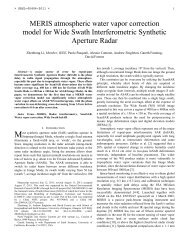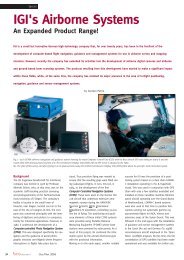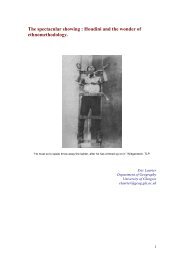Mobile Mapping Systems - University of Glasgow
Mobile Mapping Systems - University of Glasgow
Mobile Mapping Systems - University of Glasgow
Create successful ePaper yourself
Turn your PDF publications into a flip-book with our unique Google optimized e-Paper software.
Fig. 22 – This Earthmine SUV mapping vehicle is<br />
equipped with four pairs <strong>of</strong> stereo cameras mounted<br />
on a mast, each pair acquiring its 3D stereoimagery<br />
in the vertical plane in four different<br />
directions at right angles to one another. A GPS<br />
antenna is mounted at the top <strong>of</strong> the mast.<br />
(Source: Earthmine)<br />
reports that Facet<br />
Technology collected<br />
the imagery for<br />
Micros<strong>of</strong>t’s street-level<br />
photography [Fig. 21]<br />
that appeared in a<br />
somewhat experimental<br />
form in February<br />
2006 for parts <strong>of</strong> the<br />
cities <strong>of</strong> San Francisco<br />
and Seattle. See the<br />
following preview or<br />
demonstration Web<br />
site:http://preview.local.<br />
live.com. Indeed<br />
Micros<strong>of</strong>t has just<br />
announced (on 2nd<br />
December 2009) that it<br />
will be introducing an<br />
enhanced version <strong>of</strong><br />
its Streetside photography under the title <strong>of</strong> “Bing Maps Streetside”<br />
for 56 metropolitan areas in the U.S.A. As noted above, the new imagery<br />
will be supplied by NAVTEQ.<br />
Another example <strong>of</strong> an American company that is acquiring street-level<br />
photography is Earthmine Inc., which is based in Berkeley, California.<br />
This company uses SUVs equipped with a stereo-camera system whose<br />
design has been licensed from Caltech-JPL [Fig. 22]. This system uses<br />
four pairs <strong>of</strong> cameras, with each pair mounted vertically and spaced 90<br />
degrees apart horizontally. The vehicles are also equipped with the<br />
NovAtel SPAN DGPS/IMU system for position location. Each pixel in the<br />
finally processed images has 3D (X, Y, Z) coordinates. At the time <strong>of</strong><br />
writing this article, Earthmine is reported to have imaged or mapped<br />
12 metropolitan areas, mainly in the western part <strong>of</strong> the United States.<br />
On 8th December 2009, Earthmine also announced its partnership with<br />
Aero-Metric, a large American aerial mapping company, in respect <strong>of</strong><br />
the value-added resale <strong>of</strong> its street-level panoramic image data. More<br />
details on these developments can be obtained from the company’s<br />
Web site www.earthmine.com.<br />
Another relatively small company that is also engaged in this general<br />
area <strong>of</strong> photo-imaging and mapping <strong>of</strong> urban areas in the U.S.A. is<br />
EveryScape www.everyscape.com, which is based in Waltham,<br />
Massachusetts. Yet another similar company concerned with street-level<br />
photo-imaging is MapJack http://mapjack.com, which is based in San<br />
Francisco, California and has given assistance to various companies<br />
located in Sweden www.hitta.se/gatubild; Canada www.canpages.ca;<br />
and Thailand to enter this particular field. Within Europe, similar companies<br />
that undertake the photo-imaging and mapping <strong>of</strong> urban areas<br />
are Seety Ltd. www.seety.co.uk which is based in London; NORC<br />
www.norc.at which acquires street-level imagery <strong>of</strong> towns in Austria<br />
and Eastern Europe; and Cyclomedia www.cyclomedia.nl in the<br />
Netherlands – whose activities in the mobile mapping field have already<br />
been covered in an article written by the editor-in-chief (Eric van Rees)<br />
<strong>of</strong> GEOInformatics magazine which was published in the March 2009<br />
issue (Vol. 12, No. 2) <strong>of</strong> the magazine.<br />
(b) Road & Rail Maintenance & Management<br />
The other main group <strong>of</strong> commercial companies that are engaged in mobile<br />
mapping operations are those that are undertaking surveys <strong>of</strong> the road<br />
infrastructure for maintenance and management purposes on behalf <strong>of</strong><br />
Latest News? Visit www.geoinformatics.com<br />
43<br />
Article<br />
national and local government highway agencies and departments <strong>of</strong> transport.<br />
In recent years, these surveys have been extended to cover rail networks<br />
as well. Quite a number <strong>of</strong> the companies that are undertaking this<br />
type <strong>of</strong> work have already been mentioned above in the context <strong>of</strong> those<br />
customers who have purchased systems from the various systems suppliers.<br />
However there are many others that have developed their own systems<br />
in-house. A few representative examples within Europe are Omnicom<br />
Engineering www.omnieng.co.uk/index.php? id=47, which is based in York<br />
in the U.K. and is much engaged in rail as well as road surveys; and Eagle<br />
Eye Technologies www.ee-t.de from Hamburg and 3D <strong>Mapping</strong> Solutions<br />
GmbH www.3d-mapping.de/ dynasite.cfm?dssid=4324 from the Munich<br />
area in Germany. In Belgium, both the geoVISAT company www.geovisat.eu<br />
and the GeoAutomation company www.geoautomation.be/en/technology.<br />
html <strong>of</strong>fer mobile mapping services, as does the GISPRO mapping company<br />
www.gispro.pl/EN/aktualnosci. dhtml from Szczecin in Poland. There<br />
are many others! In the U.S.A., there are still more. A few representative<br />
examples are EarthEye www.eartheye.com/<strong>Mobile</strong> from Orlando, Florida;<br />
Lambda Tech www.lambdatech.com/ gpstech.html from Fort Wayne,<br />
Indiana with its GPSVision vans; Blue Dasher Technologies<br />
www.bluedashertech.com which is based in Miami, Florida; Mandli<br />
Communications Inc. www.mandli.com/systems/systems.php from Madison,<br />
Wisconsin; and the Transmap Corporation http://74.218.19.11, with its On-<br />
Sight mapping vans, which are based in Columbus, Ohio and Tampa,<br />
Florida.<br />
Summary & Conclusion<br />
As mentioned in the introduction, the development <strong>of</strong> mobile mapping systems<br />
started quite a long time ago. Initially these developments were quite<br />
modest and were not <strong>of</strong> much interest to the mainstream mapping industry.<br />
However, over the last five years, gradually the corridor mapping <strong>of</strong><br />
highways and rail networks and the 3D modelling <strong>of</strong> cities have become<br />
important applications – though at first, these activities were carried out<br />
mostly using “one-<strong>of</strong>f” mobile mapping systems built by the operators.<br />
Now the demand has grown to the point that there are several system suppliers<br />
<strong>of</strong>fering COTS products to satisfy this particular market. Then, starting<br />
three or four years ago, the increasing demand for digital road navigation<br />
data and cartographic (vector) data that could be used in personal<br />
location devices resulted in Tele Atlas and NAVTEQ entering this field with<br />
their fleets <strong>of</strong> mobile mapping vehicles. Finally, over the last two years, the<br />
Internet giants (Google and Micros<strong>of</strong>t) have created such a huge demand<br />
for visual street-level image data that a very large number <strong>of</strong> mobile mapping<br />
vehicles have been brought into operation to satisfy it, especially by<br />
Google.<br />
From this survey <strong>of</strong> current mobile mapping systems, it is also apparent<br />
that, not only is the technology now well established, but currently there<br />
are two main categories into which the resulting systems fall, largely<br />
depending on their intended applications and the quite different accuracy<br />
specifications that they have to meet. (i) On the one hand, there are those<br />
systems that are being used for the acquisition <strong>of</strong> digital images for streetlevel<br />
image display purposes and for cartographic mapping applications.<br />
(ii) On the other hand, there are those systems that are being used to collect<br />
data about the road and rail infrastructure that is needed for engineering,<br />
maintenance and management purposes. Clearly the accuracy requirements<br />
for the map or survey data that has to be measured can be<br />
substantially different in each case, with the second category usually being<br />
much more demanding in this particular respect.<br />
Gordon Petrie is Emeritus Pr<strong>of</strong>essor <strong>of</strong> Topographic Science in the Dept. <strong>of</strong><br />
Geographical & Earth Sciences <strong>of</strong> the <strong>University</strong> <strong>of</strong> <strong>Glasgow</strong>, Scotland, U.K. Email<br />
- Gordon.Petrie@ges.gla.ac.uk<br />
January/February 2010
















